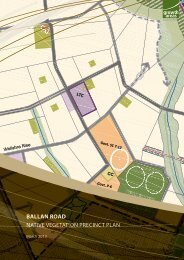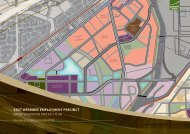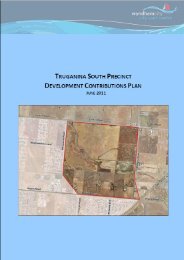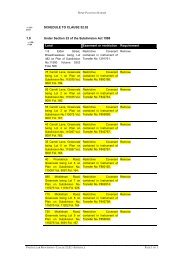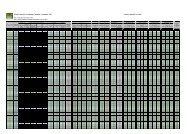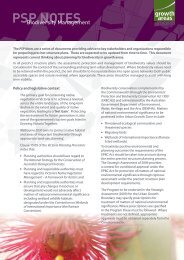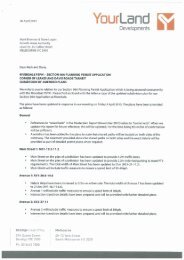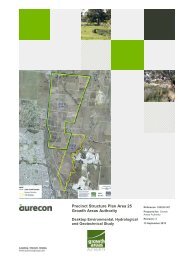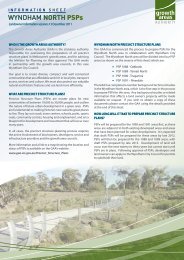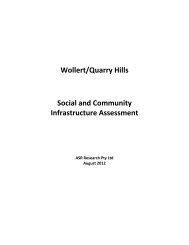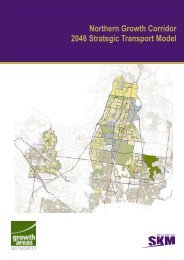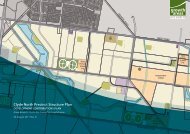The West Growth Corridor Plan - Growth Areas Authority
The West Growth Corridor Plan - Growth Areas Authority
The West Growth Corridor Plan - Growth Areas Authority
You also want an ePaper? Increase the reach of your titles
YUMPU automatically turns print PDFs into web optimized ePapers that Google loves.
4.1 COnTEXT<br />
Melbourne’s western region is<br />
one of the fastest growing in<br />
australia. the area covered by<br />
the west <strong>Growth</strong> corridor plan<br />
will eventually accommodate a<br />
population of 377,000 or more<br />
people and have the capacity to<br />
accommodate at least 164,000<br />
jobs.<br />
the region has a strong<br />
manufacturing and logistics<br />
base, and it will continue to<br />
play a vital role in meeting<br />
Victoria’s industrial and logistics<br />
needs. however, communities<br />
in Melbourne’s west are heavily<br />
reliant on the cBd and inner west<br />
for jobs and services, and this<br />
places considerable pressure on<br />
the transport network.<br />
the future development of<br />
Melbourne’s west will be<br />
substantially shaped by the<br />
following significant transport<br />
projects:<br />
> > the regional rail link (rrl)<br />
project, which will provide<br />
tracks to the north of werribee<br />
to carry Vline services from<br />
Geelong and beyond, to free<br />
up the congested werribee<br />
line to enable an improved<br />
40 | <strong>Growth</strong> corridor plans<br />
THE WEST<br />
<strong>Growth</strong> <strong>Corridor</strong> <strong>Plan</strong><br />
metropolitan service to<br />
werribee and eventually to<br />
wyndham Vale. two new<br />
stations are proposed on the<br />
rrl, at wyndham Vale and<br />
tarneit, with opportunities<br />
for four more stations in the<br />
longer term;<br />
> > the proposed outer Metropolitan<br />
ring (oMr) transport<br />
corridor – this will enhance<br />
connectivity between key<br />
international transport<br />
hubs including the port of<br />
Melbourne and Melbourne<br />
airport, and provide high<br />
speed road and rail transport<br />
links for freight and people<br />
across the west and north<br />
metropolitan area;<br />
> > the Melton rail line corridor<br />
– new stations identified at<br />
toolern and paynes road,<br />
and an upgraded station<br />
at rockbank, will provide<br />
an opportunity for transit<br />
oriented development along<br />
this corridor; and<br />
> > the proposed western<br />
interstate Freight terminal at<br />
truganina. a new intermodal<br />
freight terminal will significantly<br />
improve Melbourne’s<br />
freight handling capacity and<br />
reinforce the economic importance<br />
of Melbourne’s west.<br />
creating greater local self<br />
containment, job and housing<br />
diversity, and improved transport<br />
links are priorities for the western<br />
metropolitan region. the west<br />
<strong>Growth</strong> corridor plan seeks to<br />
address these priorities by:<br />
> > improving road, public transport<br />
and freight networks<br />
across the region;<br />
> > Extending the western industrial<br />
node, and connecting<br />
it to a new freight terminal<br />
and the broader transport<br />
network;<br />
> > creating a diversity of new<br />
communities, well serviced<br />
by public transport and with<br />
very high amenity by building<br />
on natural features such as<br />
regional parklands, creeks<br />
and waterways, and creating<br />
high quality town centres and<br />
urban areas; and<br />
> > creating attractive and accessible<br />
locations for a wide<br />
range of jobs, investment, and<br />
services – including in six new<br />
higher order town centres.




